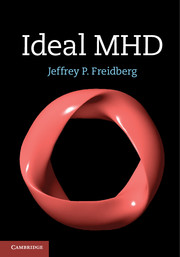Book contents
- Frontmatter
- Dedication
- Contents
- Preface
- Acknowledgements
- 1 Introduction
- 2 The ideal MHD model
- 3 General properties of ideal MHD
- 4 MHD equilibrium: general considerations
- 5 Equilibrium: one-dimensional configurations
- 6 Equilibrium: two-dimensional configurations
- 7 Equilibrium: three-dimensional configurations
- 8 MHD stability – general considerations
- 9 Alternate MHD models
- 10 MHD stability comparison theorems
- 11 Stability: one-dimensional configurations
- 12 Stability: multi-dimensional configurations
- Appendix A Heuristic derivation of the kinetic equation
- Appendix B The Braginskii transport coefficients
- Appendix C Time derivatives in moving plasmas
- Appendix D The curvature vector
- Appendix E Overlap limit of the high β and Greene–Johnson stellarator models
- Appendix F General form for q(ψ)
- Appendix G Natural boundary conditions
- Appendix H Upper and lower bounds on δQKIN
- Index
- References
10 - MHD stability comparison theorems
Published online by Cambridge University Press: 05 July 2014
- Frontmatter
- Dedication
- Contents
- Preface
- Acknowledgements
- 1 Introduction
- 2 The ideal MHD model
- 3 General properties of ideal MHD
- 4 MHD equilibrium: general considerations
- 5 Equilibrium: one-dimensional configurations
- 6 Equilibrium: two-dimensional configurations
- 7 Equilibrium: three-dimensional configurations
- 8 MHD stability – general considerations
- 9 Alternate MHD models
- 10 MHD stability comparison theorems
- 11 Stability: one-dimensional configurations
- 12 Stability: multi-dimensional configurations
- Appendix A Heuristic derivation of the kinetic equation
- Appendix B The Braginskii transport coefficients
- Appendix C Time derivatives in moving plasmas
- Appendix D The curvature vector
- Appendix E Overlap limit of the high β and Greene–Johnson stellarator models
- Appendix F General form for q(ψ)
- Appendix G Natural boundary conditions
- Appendix H Upper and lower bounds on δQKIN
- Index
- References
Summary
Introduction
Three models have been introduced to investigate the MHD equilibrium and stability properties of a general multidimensional magnetic fusion configuration: ideal MHD, kinetic MHD, and double adiabatic MHD. Ideal MHD is by far the most widely used model although there is concern since the collision dominated assumption used in the derivation is not satisfied in fusion-grade plasmas. The collisionless kinetic MHD model provides the most reliable description of the physics but is difficult to solve in realistic geometries because of the complex kinetic behavior parallel to the magnetic field. Double adiabatic MHD is a collisionless fluid model that is much easier to solve than kinetic MHD but the closure assumptions cannot be justified by any rigorous mathematical or physical arguments.
Based on this assessment one sees that the situation is not very satisfactory from a theoretical point of view. In practice, ideal MHD, because of its mathematical simplicity, is the model that is most widely used to design, predict, and interpret fusion experiments. Many years of experience have shown, perhaps surprisingly, that the model is far more accurate and reliable than one might have anticipated.
- Type
- Chapter
- Information
- Ideal MHD , pp. 400 - 427Publisher: Cambridge University PressPrint publication year: 2014



